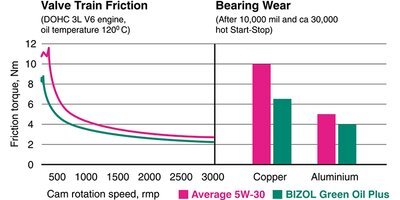HOW FUEL EFFICIENT IS A FRICTION MODIFIER ADDITIVE?
High standards for the motor oil and automotive industry
The environmental pressure on the automotive industry continues to grow: the National Highway Traffic Safety Administration (NHTSA) and the Environmental Protection Agency (EPA) have issued the Safer Affordable Fuel-Efficient Vehicles Rule (SAFE) in the USA, where less CO2 emissions and more fuel savings are among the contents of this publication. The European Parliament and authorities in Japan have also issued new regulations that require the reduction of CO2 emissions. The relevance of fuel-efficient oils is increasing!
Advances in engine and motor oil technology
For this reason, the automotive industry is increasingly focusing on the development of fuel-efficient engines, among other things. The latest technologies in engine technology are smaller, lighter and more efficient. So-called downsized engines with less displacement but comparable performance require less fuel than other engines. BIZOL and the motor oil industry is also optimising lubricant technology, since about one third of fuel consumption is attributable to friction losses associated with the drive system.
WLTP test conditions prove fuel savings
Scientific papers such as “Fuel Economy Engine Oils: Scientific Rationale and Controversies”, show that “…For passenger cars, a change from the legacy SAE 10W-40 grade to 0W-20 brings on average 5% improvement in fuel economy under the WLTP test conditions, and the subsequent migration to 0W-8 can bring additional 5%, provided that engine hardware can safely handle such a low viscosity.”
Improved coefficients of friction via Friction Modifier Additives
But lower oil viscosity can also mean less protection against friction, and here is where the lubricant industry is working hard. For a long, damage-free and fuel-saving operation of the engines, the friction and wear between the moving parts must be minimised as much as possible via the lubricant. The use of low-viscosity engine oils and the addition of state-of-the-art additives with friction modifiers (FM) reduces unnecessary friction and energy losses and lowers fuel consumption.

You might also like

Prof. Dr. Boris Zhmud, Head of R&D, BIZOL Germany

Within the realm of automotive care, few substances are as vital as motor oil, in ensuring the seamless operation of a vehicle's propelling device. It serves as the lifeblood of a motor, ensuring that the intricate machinery operates efficiently and without unnecessary friction. The functions of motor lubricant substance extend far beyond just lubrication, encompassing a range of critical tasks that contribute to the longevity and performance of a propelling mechanism. In this article, we’ll delve into the multifaceted functions of motor oil and explore how it plays a pivotal role in maintaining the health of automotive powerhouses.

The modern marvel of an internal combustion motor powers our vehicles, providing the strength and reliability we rely on for daily transportation. However, just like anything else subjected to constant use, motorized units experience wear and tear over time. Component deterioration can significantly impact performance and longevity. In this article, we will delve into the intricacies of engine wear meaning, explore the various causes behind it, provide actionable tips to reduce and prevent it. Furthermore, we will look at how specialized engine oils, such as BIZOL, play a crucial role in safeguarding your engine’s health. Let’s begin by understanding what engine wear is and the factors that contribute to it.

